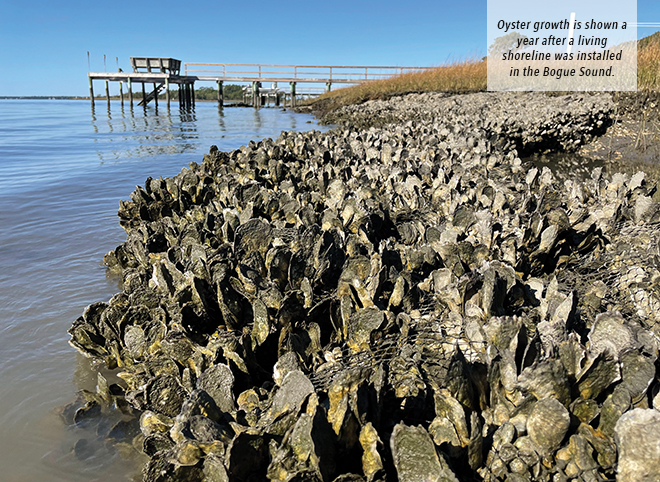Coastal Carolina’s sea level is rising. River flooding has become more problematic. And hurricanes are here to stay.
The facts behind these threats to the region’s neighborhoods, economy and lifestyle are incontrovertible. The question is whether the response by property owners, business leaders, environmentalists and elected officials will prove sufficient to thwart significant long-term damage.
According to SeaLevelRise.org, the sea level around Wilmington has risen 11 inches since 1950 and has accelerated over the past decade, as measured by satellites, buoys and tidal gauges. Scientists say melting ice from the North and South poles and the slowing of the Gulf Stream are the primary culprits.
King tides – unusually high tides that are more than a foot higher than normal – in Wilmington create flooding even on sunny days, both along the ocean and inland because of celestial alignments. While king tides normally occur once or twice a year for areas along the coast, they can preview how sea level rise might impact those areas in the future as tidal system heights gradually rise, according to the Environmental Protection Agency.
With the 2022 hurricane season underway, public attention is again starting to focus on the risk of inaction.
“A big hurricane like Florence certainly encourages urgency,” said Tony McEwen, Carolinas director for the American Flood Coalition, a national group that works with elected officials at the local, state and federal levels as well as businesses, the military and civic groups. Its objective is to build “a unified voice” for solutions to sea rise and flooding.

“And we’re entering what could be the eighth active hurricane season in a row. So, as more and more Carolinians see the impacts of stronger storms, rising sea levels and more frequent flooding pile up, there’s going to be more talk and more demands for solutions,” said McEwen (
left), who previously served as the city of Wilmington’s assistant to the city manager for legislative affairs.
Last year, the coalition and other organizations lobbied Congress to increase financial support for flood mitigation, resilience and disaster preparedness programs, with $34.7 billion finding its way into a bipartisan package.
Also last year, the N.C. General Assembly passed “historic” levels of funding for flood resilience and disaster recovery as part of the state budget, according to McEwen, who said much of that funding was influenced by the advocacy of the Eastern N.C. Recovery and Resilience Alliance, begun by Wilmington Mayor Bill Saffo following Hurricane Florence and now led by Saffo and Pender County Commissioner Jackie Newton. The alliance currently includes more than 60 mayors and chairs of county commissions.
While flood cleanup is important, the coalition’s emphasis on prevention is central to the group’s agenda, McEwen said, with a single dollar spent on predisaster mitigation saving $5-$7 in disaster relief.
“FEMA’s (Federal Emergency Management Agency) maps often are outdated, do not account for sea-level rise and overlook rainfall and riverine flooding. To put it plainly, these maps can significantly underestimate flood risk … Relying on outdated flood maps gives people a false sense of confidence, through no fault of their own,” McEwen said. “We’re starting to explore how incentives can encourage resilient building on the front end and not just in rebuilding.”
EMERGING SOLUTIONS
Beach nourishment is one tried-and-true method of combating erosion and protecting against storm surge. Its first usage was at New York’s Coney Island 100 years ago.
The practice involves pumping and laying into place sand imported from nearby sources, which in turn produces a wider and higher beach that serves as a buffer against damage to coastal structures. The practice also enhances beaches popular with tourists and locals. Dune restoration often accompanies such projects.

Funding for nourishment projects at Wrightsville Beach, Carolina Beach and Kure Beach was recently approved by Congress. The U.S. Army Corps of Engineers began work at the latter two sites in February and completed both projects by June 1.
Those projects “equated to roughly 1 million cubic yards of sand placed for each beach or 2 million total,” said David Connolly, chief of public affairs for the Army Corps’ Wilmington District.
Wrightsville Beach’s nourishment was delayed due to rules within the Coastal Barrier Resource Act that prohibited borrowing sand from Masonboro Inlet, so the Corps had to identify another offshore source. Nourishment work is expected to begin at Wrightsville this fall.
Meantime, a newer approach to addressing erosion has caught the attention of both residential and commercial property owners who have traditionally used seawalls and bulkheads.
Introduced by Native Shorelines, a Raleigh-based environmental engineering firm, the Living Shorelines program works with residents and businesses to thwart erosion using fabricated blocks made primarily of coastal materials like limestone marl and oyster shell and placed along the shoreline.
When a wave hits a hard surface like a bulkhead, it bounces back out to sea and also spills over into a neighbor’s shoreline, while the blocks of a living shoreline absorb most of a wave’s energy but also allow some water into the adjoining marsh. This helps the marsh thrive and the surrounding ecosystem to flourish, explained Mary-Margaret McKinney, the firm’s director of coastal restoration.
Living shorelines often cost less than $200-per-foot to install and require little to no maintenance, McKinney said. Cost-sharing is available through the N.C. Coastal Federation.
“We currently have projects in progress from Brunswick County by the South Carolina border all the way to Perquimans County by the Virginia border,” with more than 100 living shorelines projected to be in place by year’s end, McKinney said.
Such innovative solutions might pay off in the form of reduced insurance payments.
“FEMA recently implemented Risk Rating 2.0, essentially updating the National Flood Insurance Program to focus more on individual property risk,” McEwen said. “This update actually reduced premiums: 89% of flood insurance policyholders saw their premiums either immediately drop or increase by no more than $10 per month.”
FROM SEA TO RIVER
The west bank of the Cape Fear River across from downtown Wilmington is another area that merits close attention when addressing future water damage, according to Robert Parr, a retired oceanographer and former physician who lives at Middle Sound.

Parr said there are four components to flooding around the west bank: river flooding, tidal flooding, storm surge flooding and sea-level rise flooding, a “quadruple threat” in a location with the distinction of “having the highest increase in tidal flooding frequency on both the East and West Coast.”
Projections by the National Oceanic and Atmospheric Administration predict a sea-level rise on the west bank as high as 1.5 to 2 feet by 2050, Parr said.
Parr remains outspoken about proposals for commercial development on the west bank, including the contentious Battleship Point mixed-use complex whose backers have not yet won municipal approval.
“As some of the lowest-lying land in New Hanover County, new intense urban-style development has no future on the west bank,” he said.
In a possible harbinger of bad tidings, flooding has required repairs at the site of Battleship North Carolina, moored among 2,000 acres of wetlands and shoreline on Eagles Island.
“The battleship has seen more flood stage events in the past decade than in the previous 60 years” with 101 flooding events in 2018 alone, says a write-up on the historic attraction’s website.
The frequency and severity of floods have led to safety concerns and economic losses, including damage to facilities, disrupted utility services, strains on ship structure, public closures and lost revenues, officials said.
In January, the battleship ranked fourth among area attractions with 195,000 visitors last year.
To head off further damage, battleship officials are restoring one-fifth-acre of hardened shoreline with a living shoreline and a 2-acre, flood-prone area of a parking lot with wetland habitat.
“All sorts of innovative solutions exist to reduce the impacts of sea level rise, and we must continue funding these measures and determining what works best for each community. Such solutions in one community can mean seawalls, pumps and drains, and in another community, it can mean more parks, living shorelines and oyster-covered reefs. Often, it will be a little bit of everything – policy, hard infrastructure, natural infrastructure,” McEwen said. “Overnight, flooding can upend communities and livelihoods for years. And though big storms briefly dominate headlines, communities take years to recover. The damage from flooding is a costly reminder that we must adapt.”

 “And we’re entering what could be the eighth active hurricane season in a row. So, as more and more Carolinians see the impacts of stronger storms, rising sea levels and more frequent flooding pile up, there’s going to be more talk and more demands for solutions,” said McEwen (left), who previously served as the city of Wilmington’s assistant to the city manager for legislative affairs.
“And we’re entering what could be the eighth active hurricane season in a row. So, as more and more Carolinians see the impacts of stronger storms, rising sea levels and more frequent flooding pile up, there’s going to be more talk and more demands for solutions,” said McEwen (left), who previously served as the city of Wilmington’s assistant to the city manager for legislative affairs. Funding for nourishment projects at Wrightsville Beach, Carolina Beach and Kure Beach was recently approved by Congress. The U.S. Army Corps of Engineers began work at the latter two sites in February and completed both projects by June 1.
Funding for nourishment projects at Wrightsville Beach, Carolina Beach and Kure Beach was recently approved by Congress. The U.S. Army Corps of Engineers began work at the latter two sites in February and completed both projects by June 1. Parr said there are four components to flooding around the west bank: river flooding, tidal flooding, storm surge flooding and sea-level rise flooding, a “quadruple threat” in a location with the distinction of “having the highest increase in tidal flooding frequency on both the East and West Coast.”
Parr said there are four components to flooding around the west bank: river flooding, tidal flooding, storm surge flooding and sea-level rise flooding, a “quadruple threat” in a location with the distinction of “having the highest increase in tidal flooding frequency on both the East and West Coast.”


